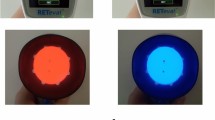Abstract
The measurement of the light rise of the corneoretinal potential in the clinical routine depends critically on the constancy of the eye movements made by the subject. To verify to what extent the variability of the Arden ratio can be explained by the variability of these eye movements, an infrared sclerai reflection technique was applied in order to monitor eye positon and electrooculogram simultaneously. The data obtained in 10 normal subjects show that not only is the variability reduced substantially by correction for the actual eye movement, but also the routine procedure gives a systematic underestimation of the ratio. Monitoring eye movements makes available the use of eye movements of arbitrary size (e.g., optokinetic nystagmus), allowing for application of the method in uncooperative subjects such as children.
Similar content being viewed by others
References
Steinberg RH. Monitoring communications between photoreceptors and pigment epithelial cells: Effects of “mild” systemic hypoxia. The 1987 Friedenwald Lecture. Invest Ophthalmol Vis Sci 1987; 28: 1881–1904.
Arden GB, Barrada A and Kelsey JH. New clinical test of retinal function based upon the standings potential of the eye. Br J Ophthalmol 1962; 46: 449–67.
North AW. Accuracy and precision of electrooculographic recording. Invest Ophthalmol Vis Sci 1965; 4: 343–8.
Van Lith GHM, Balik J. Variability of the electrooculogram (EOG). Acta Ophthalmol 1970; 48: 1091–6.
Dawson WM, Maida TM. Reduced variability in the elctrooculogram. Am J Ophthalmol 1984; 97: 395–6.
Reulen JP, Marcus JT, Koops D, de Vries FR, Tiesinga G, Boshuizen K, Bos JE. Precise recording of eye movements: the IRIS technique, Part I. Med Biol Eng Comput 1988; 26: 22–6.
DeWaal BJ, Reits D, Spekreijse H, Grimbergen CA. Implemention of a portable pattern and VEP/ERG recording system on an Apple microcomputer. Doc Ophthalmol Proc Series 1983; 37: 209–216.
Weleber RG. Fast oscillations of the EOG in Best's dystrophy and retinitis pigmentosa. ISCEV meeting, Estoril, Portugal 1988.
Author information
Authors and Affiliations
Rights and permissions
About this article
Cite this article
Riemslag, F.C.C., Lunel, H.F.E.V. & Spekreijse, H. The electrooculogram: A refinement of the method. Doc Ophthalmol 73, 369–375 (1989). https://doi.org/10.1007/BF00154492
Received:
Accepted:
Issue Date:
DOI: https://doi.org/10.1007/BF00154492




